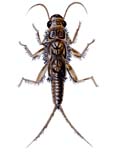UPCOMING EVENTS
View full calendarAquatic Macroinvertebrates

Helpful Resources
 |
 |
| Dragonfly larva |
Dragonfly adult |
Factors that Influence Macroinvertebrate Health
Natural influences:
Seasons - life histories of invertebrates are tied to food availability. For example, macroinvertebrates that eat algae are most abundant in the summer when algae production is at its highest.
Dissolved Oxygen - macroinvertebrates breathe oxygen that is dissolved in the water. In the immature stage, many species require high levels of dissolved oxygen in order to survive.
Substrate - what the bottom of the stream is comprised of will affect the types of macroinvertebrates. For example, macroinvertebrates that eat tiny food particles prefer sandy or muddy substrate.
Human influences:
Nutrient enrichment - added nutrients from human sewage, fertilizer or manure can accelerate the growth of algae and other plants. When these plants die decomposition by microorganisms can use up dissolved oxygen in the water.
pH - Dumping of industrial pollutants and runoff from mining activities can lower pH (making water more acidic). Low pH can weaken shells and exoskeletons and kill macroinvertebrates.
Removal of riparian vegetation - this takes away macroinvertebrates' food source and important breeding grounds.
Why Care About Aquatic Macroinvertebrates?
 They are indicators of water quality. Different types of macroinvertebrates tolerate
different stream conditions and levels of pollution. Depending on the types of macroinvertebrates
found in a stream, predictions about water quality can be made. For example, caddisflies,
mayflies, and stoneflies can not live in polluted water. If these bugs are found in
a stream, the water quality there is probably good. However, that doesn't mean that
if these bugs are not found in a stream the water quality is bad. Other factors like
temperature and flow also come into play. These bugs prefer cold rushing water, so
a stream that has good water quality, but is a slow-moving stream in a desert may
not have these bugs.
They are indicators of water quality. Different types of macroinvertebrates tolerate
different stream conditions and levels of pollution. Depending on the types of macroinvertebrates
found in a stream, predictions about water quality can be made. For example, caddisflies,
mayflies, and stoneflies can not live in polluted water. If these bugs are found in
a stream, the water quality there is probably good. However, that doesn't mean that
if these bugs are not found in a stream the water quality is bad. Other factors like
temperature and flow also come into play. These bugs prefer cold rushing water, so
a stream that has good water quality, but is a slow-moving stream in a desert may
not have these bugs.
Aquatic macroinvertebrates are also an important part of aquatic and terrestrial food chains. They graze on algae and break down leaves and sticks that fall into the water. They are also an important food source for fish.
Want to Learn More?
Lesson plans about aquatic macroinvertebrate adaptations, feeding habits, life history strategies, as well as pictures and bug keys can be found at https://extension.usu.edu/waterquality/educator-resources/lessonplans/macro/.
Also check out http://macroinvertebrates.org for additional information.
